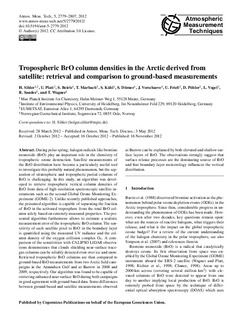Tropospheric BrO column densities in the Arctic derived from satellite: retrieval and comparison to ground-based measurements
Sihler, H.; Platt, U; Beirle, S.; Marbach, T.; Kühl, S.; Dörner, S.; Verschaeve, Joris C. G.; Friess, U.; Pöhler, D.; Vogel, Lotte K.; Sander, R.; Wagner, T.
Journal article
Permanent lenke
http://hdl.handle.net/11250/2375294Utgivelsesdato
2012Metadata
Vis full innførselSamlinger
- NGI articles [1061]
Sammendrag
During polar spring, halogen radicals like bromine monoxide (BrO) play an important role in the chemistry of tropospheric ozone destruction. Satellite measurements of the BrO distribution have become a particularly useful tool to investigate this probably natural phenomenon, but the separation of stratospheric and tropospheric partial columns of BrO is challenging. In this study, an algorithm was developed to retrieve tropospheric vertical column densities of BrO from data of high-resolution spectroscopic satellite instruments such as the second Global Ozone Monitoring Experiment (GOME-2). Unlike recently published approaches, the presented algorithm is capable of separating the fraction of BrO in the activated troposphere from the total BrO column solely based on remotely measured properties. The presented algorithm furthermore allows to estimate a realistic measurement error of the tropospheric BrO column. The sensitivity of each satellite pixel to BrO in the boundary layer is quantified using the measured UV radiance and the column density of the oxygen collision complex O4. A comparison of the sensitivities with CALIPSO LIDAR observations demonstrates that clouds shielding near-surface trace-gas columns can be reliably detected even over ice and snow. Retrieved tropospheric BrO columns are then compared to ground-based BrO measurements from two Arctic field campaigns in the Amundsen Gulf and at Barrow in 2008 and 2009, respectively. Our algorithm was found to be capable of retrieving enhanced near-surface BrO during both campaigns in good agreement with ground-based data. Some differences between ground-based and satellite measurements observed at Barrow can be explained by both elevated and shallow surface layers of BrO. The observations strongly suggest that surface release processes are the dominating source of BrO and that boundary layer meteorology influences the vertical distribution.
Beskrivelse
-
